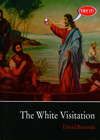The White Visitation
I was reading The White Visitation in the Detroit International Airport, waiting for my flight to Charleston, when the Iraqi gentleman on my left nudged my arm. “Is that the bible?” he asked.
I was reading The White Visitation in the Detroit International Airport, waiting for my flight to Charleston, when the Iraqi gentleman on my left nudged my arm. “Is that the bible?” he asked.
I closed the book, and the two of us pondered its cover art: "a 1949 painting of Christ, cloaked arm outstretched…Into Christ’s open hand has been pasted, yes, one hot-pink iPod nano…by bright red bubble caption Christ proselytizes, 'Try it!'”
A moment prior, he and I had been discussing why his cell phone – we had the same model – wouldn’t take pictures, and the weather in Idaho compared to Michigan and the Middle East. The sudden cultural implications of his question threw me off balance. Awestruck, I fumbled for an appropriate answer. “No,” I began.
I too had judged its cover, coming to very nearly the opposite conclusion. The reason I had chosen to read The White Visitation in the first place was simply because of its patently sacrilegious cover; I was fully anticipating (welcoming, desiring) a satire of the Christian subculture, and expecting a possible poetic re-hashing of “What White People Like.”
Neither hypothesis was quite correct, though David Brennan toys with both. He quotes Transformers II and alludes to Arrested Development. One poem consists of cringe-worthy Caucasian gerunds in the club: “humping in the club, mad texting in the club, self-loving in the club, get your sad self to the club…gin and juicing in the club.”
On the religious front, T.W.V. says he only wants to “be spacious, to settle, to resolve God.” He attempts to do so in “General Rule 7.3,” and text from the optional passages of Stoppard’s Rosencrantz and Guildenstern Are Dead:
BIBLE – ANTIQUITIES
BIBLE – ANTHOLOGY
Bible. N.T. Polish. 1953
Bible. N.T. Vietnamese. 1967
BIBLE. N.T. – BIOGRAPHY
Bible. N.T. Acts. English. Jerusalem Bible. 1978
BIBLE. N.T. ACTS—COMMENTARIES
[ROS. It’s all questions.
GUIL. Do you think it matters?]
(Later, a continuation of “7.3” collects translations of the Divine Comedy, followed by what the book’s Notes call a “faux gaffaw. A façade of a cachinnation” – “Ha. Ha ha ha. Heh-heh.” and on and on.)
As much as I wanted stinging religious parody, about half way through I was tempted to call The White Visitation a prayer book: “It is language that fails emotion; witness the promiscuousness of tongues. A work about a title.” However, a prayer book that is too aware of itself, like all immortals attempting to reach God at his/her home office, or white people in the age of the internet, or a young man smacking into language barriers with a man from Twin Falls by way of Baghdad.
That being said, The White Visitation appears to be borne completely of self-awareness. It’s the story of two presences: The White Visitation (T.W.V., “the real or pseudonymous name I go by,” says the speaker), and the mysterious poet Ned Ravinband and his “hyphenated incoherent” poem, “Night, Sleep, Death, & the Stars.” T.W.V. attempts to reconcile the existence of Ravinband through a series of General Rules, Special Rules, Exceptions, and the Seven Assumptions. But the logic is post-Einstein, and the rules T.W.V. establishes curve like time and space. Therefore, a dash becomes a space, “what is white is horse,” and the lines between T.W.V. and Ned Ravinband are blurred. In one poem, T.W.V. admits “when two or more authors are identical, makes no effort to arrange them within their group.” In another, The White Visitation is “a dream of myself I had.” These, and other hints (including the Rosencrantz and Guildenstern dialogue, Michael Martone’s blurb on the back cover, and the overt anagram), are keys to the identity crisis.
So it’s like the bible, in that the Good Book contains the phrase, “now we see as in a mirror.” And it’s like Sartre, who was an existential atheist, in that we see ourselves in the Other.
There’s more to it, of course. There always is, no matter how many Special Rules and Assumptions are applied. Simply: David Brennan, like the patients of the mental hospital that shares his title and “corporate body,” is a wild talent, a clairvoyant, and a mad magician.
“It looks like a bible to me,” he said.
I shrugged, flipping through the pages. “It’s just some poetry.”





